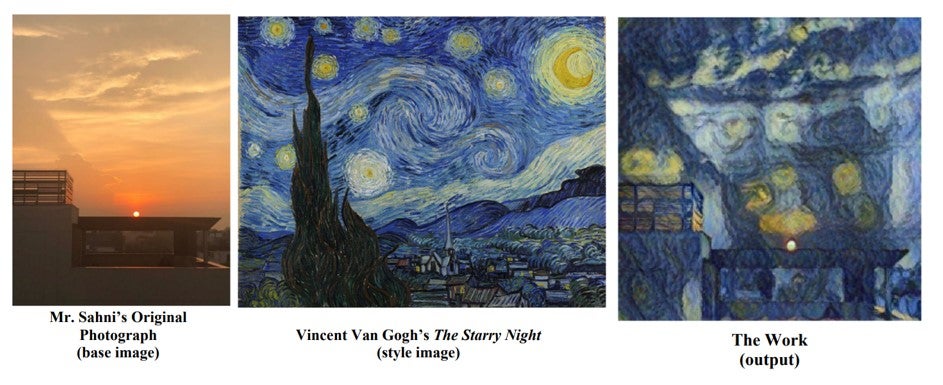Copyright Office Review Board Denies AI-Human Authorship Claim for Third Time
In an opinion issued on December 11, the US Copyright Office Review Board affirmed a refusal to register a work of art created in part by generative artificial intelligence (AI), concluding that the work lacked the “human authorship” necessary to claim copyright protection.
The opinion is just the third time the Board has issued a written opinion analyzing the impact of generative AI on copyright protection.
The Work in Question
The opinion involves a copyright application filed by an individual named Ankit Sahni who sought to register a two-dimensional artwork entitled “SURYAST.” Sahni generated the work by taking an original photograph that he authored, inputting that photograph into an AI painting tool, and then inputting a copy of Vincent van Gogh’s “The Starry Night” as the “style” input to be applied to the photograph. He also chose “a variable value determining the amount of style transfer.”
Below are copies of the original photograph; “The Starry Night”; and the resulting work:

Sahni argued that the decisions he made are sufficient to make him the “author” of the work . In particular, he asserted that “conceiving, creating and selecting an original [base] image,” “selection of the style image,” and “selecting a specific variable value determining the amount and manner of style transfer” cumulatively resulted in a copyrightable work that is the direct outcome of his creative expression and contribution. According to Sahni, it was his creative control and decision making which resulted in the work containing a sunset; clouds; the contours of a building; a composition in which the sky accounts for the upper two thirds of the work; and “a precise and deliberate style of Van Gogh’s [The] Starry Night.” In his view, the AI tool was merely “an assistive tool” that worked similarly to “a camera, digital tablet, or a photo-editing software program,” all of which are capable of creating works protectible by copyright.
The Copyright Office and the Review Board disagreed, concluding that the work is not the product of human authorship and therefore not protectible. Rather than exerting creative control, the Board viewed Sahni as little more than a paper pusher, feeding source material to the AI tool, which then created a new work on its own via mathematical formula.
As noted, this is the third time the Review Board has addressed copyright protection for works created in part with generative AI. While each opinion offers useful guidance to creators and artists who use generative AI in the creative process, it also reflects a refusal on the part of the Copyright Office and Board to recognize and appreciate the many new ways human authors are using generative AI tools to create new expressive works. If the Board continues to deny copyright protection for work generated in part by AI, human creators and artists may argue they risk being penalized merely for the tools they choose to use to express themselves.
- Related Industries
- Related Practices